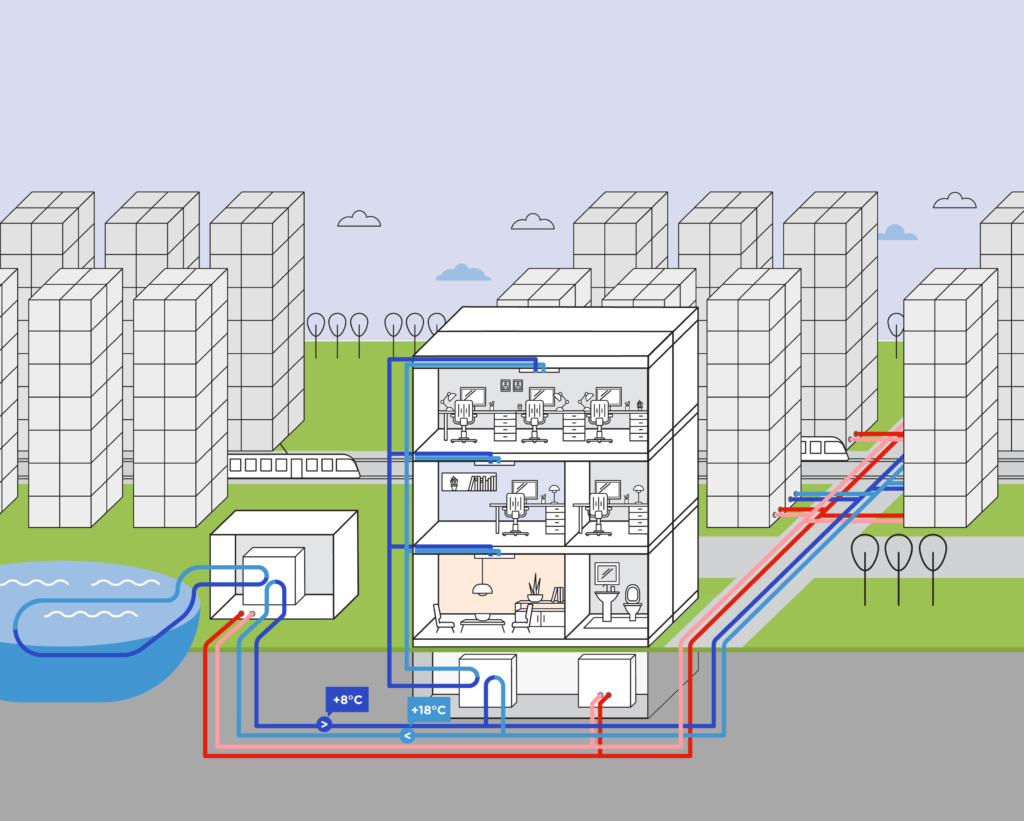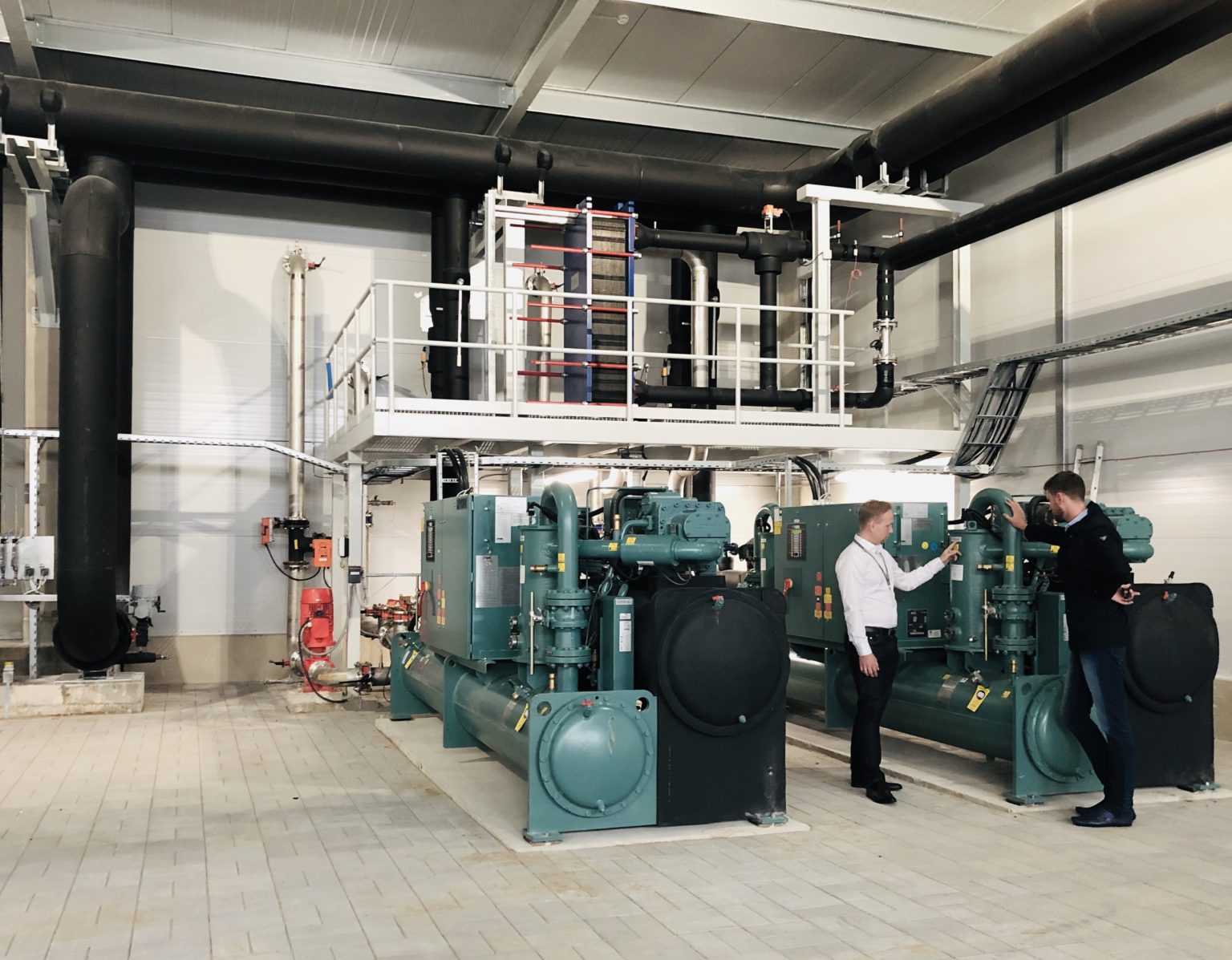District heating systems have been developed in Estonia as a solution suitable for cities and densely populated areas for decades; yet, district cooling is a relatively new concept. However, Helsinki and Stockholm, for example, have increased their district cooling networks 4–5 times over the last 10 years, whereas the 400 MW district cooling network of Stockholm was the largest in the world until recently.
By now, Middle Eastern countries have also discovered the efficiency of district cooling. For example, the cooling of the Doha 2019 World Athletics Championships stadium was specifically provided by a mega-powerful district cooling system. An example of a neighbouring country in recent years is the shopping centre Mall of Tripla in Helsinki, which stands out by its environmental awareness: besides being connected to a district cooling system, it also houses the first bicycle hotel in Finland, 1/3 of the roof of the building is covered by green space and the centre is equipped with a special garbage system, where the garbage moves from the centre to a designated place through pipes.
“The size of the district cooling networks in Finland and Sweden may seem strange at first glance; however, knowing their green view of life, there is nothing to be surprised of. It is highly valued over there that district cooling helps to reduce the use of environmentally harmful refrigerants and enables to replace them with environmentally friendly artificial or natural refrigerants. In addition, it is a reliable, secure, and wallet-friendly cooling method,” says Andres Veske, head of the district heating companies of Utilitas, the largest renewable energy production company in Estonia.
Today, Utilitas has one large district cooling park in the Fahle region, i.e., in the former Zelluloosi quarter. The next project will most likely be the Ülemiste City, where two developers want to connect also to the district cooling system, in parallel to district heating and in addition, the company is planning a common district cooling system into the region between the Tallinn Department Store, the “skylines quarter” and the streets of Juhkentali and Liivalaia with total capacity of 50–60 megawatts.
According to Veske, environment is a very important aspect. “The European Union, Estonia, but also Tallinn, have set several climatic goals and without district cooling, these are difficult to achieve. These goals are ambitious. For example, Estonia wants to be climate neutral by 2050. After we realise our district cooling projects, it will save around 15,000 tonnes of CO2 for Tallinn each year.
Another advantage besides being environmentally friendly is the fact that district cooling systems are ten times more effective than using local solutions. This, in turn, helps the developers (who besides district heating use also district cooling) to achieve the requested energy efficiency ratio more easily, since district heating and cooling bring this ratio significantly down. Besides thinking green, developers have taken interest in district heating and cooling because it has short payback time and enables to use the space required by local devices for other purposes. For example, it is possible to establish a green space or beehives on the roof instead of cooling equipment, or, lease out the freed-up space.

The production and distribution of district cooling resembles district heating. Cooled water (about 6°C) is led from the district cooling plant to the cooling assembly in a client’s building. Within the assembly, this water is used to cool the ventilated air in the building and the water circulating in the cooling system of the building.
Sea and immense cooling potential
Tanel Kirs, the project manager of district cooling, states that generally, district cooling is quite the same everywhere in the world: “While in the case of heating, we bring the hot heat exchange medium into the building and get coolness in return, then when cooling, it is the other way round – the cool heat exchange medium enters the building and returns the heat. Accordingly, heat is directed to circulation, where it is cooled in the meantime. The difference, however, is in the production methods of cooling. As a seaside city, it makes sense to use the cooling potential of sea water and specifically the low temperature of sea water in Tallinn. It is very common in the world. Stockholm and Helsinki, for example, widely use sea water as a free cooling source. It is cheap, efficient, and renewable.”
Using sea water in district cooling, its potential is mainly related to the depth of the sea. Therefore, one must assess its capacity to dive into cooler water layers. “Year-round cooling from the sea would mean a depth of more than 40 meters, unfortunately, however, we do not have such a possibility. Yet, mathematically, the free cooling obtained from the Baltic Sea covers half of our annual need,” Kirs states. At the same time, if the wind blows constantly from the land even in hot weather, which takes the warm water layers far away to the sea, this water temperature is fine for cooling. But, once the temperature of sea water starts to rise, the equipment will begin cooling the water thanks to the automation and residual heat from energy production.
If we talk more specifically about using sea water for cooling, then sea water is taken from as deep as possible, it is pumped through a closed heat exchanger of the district cooling station, the cooling water flowing in the system is cooled with it, and then, the water is re-directed back to the sea. At the same time, sea water does not come into contact with or mix with the chemically treated water flowing in the systems, the sea water is only used to cool the water circulating in the system. Considering the small amount of sea water used, it does not affect the temperature of a large waterbody.
Tartu and Pärnu use river water for free cooling, which is slightly warmer compared to sea water. “Due to its coolness, the use of sea water is more efficient of course; but at the same time, there are devices through which it is not possible to pump it due to its salinity. So, each solution has its pros and cons. At the same time, the Baltic Sea is of course not as salty compared to other seas,” Kirs adds.

Cooling through chemical process and cooling tower
But there are also other possibilities – for example, to use the residual heat from the above-mentioned energy production in the cooling processes. This allows the power plants to produce electricity even more efficiently as they do not generate residual heat. This works in such a way that in summer, energy production is the most efficient when cooling the residual heat with absorption equipment, where the coolness is generated through a thermochemical process. This coolness in turn is directed to the district cooling network.
“However, if there is no sea water to use for cooling, the coolness generated by evaporation of warm water will be used. All Tallinners probably know the big cooling tower on Peterburi tee in Iru. This is used to cool down the heat generated in the turbine. A cooling tower is a water-cooling device, which cools water by partial evaporation and direct heat transfer into the air. The water led through the turbine’s capacitor is directed through the cooling tower, where the water is sprayed and cooled down. As a similar process, the cooling tower may also be used in cooling the refrigeration systems. This is done for example in Tartu,” said Kirs. In Fahle Park, however, the air is used as a free cooling source – the required temperature is taken from the air and used to cool the cooling water.
“There are more cooling technologies based on the example of our northern and southern neighbours, but not all of them fit Estonia’s profile, although we have considered these. These technologies are in particular heat pumps and energy storage, but heat pumps would be suitable above all for places where you need heat in summer. In Tallinn, for example, there is no such need,” Kirs explains. “Energy storage, on the other hand, suits more to warmer locations, to save power. Considering the possibilities of Tallinn, free cooling and conversion of residual heat are the best solutions.”
Safety is no less important
Veske points out that today, customers want environmentally friendly and hassle-free solutions at a good price – district cooling and district heating offer just that. “A customer does not have to make a large initial investment and will get the service at a reasonable price. District cooling devices do not generate noise, do not contain or emit harmful substances, and do not burden the environment. Compared to local solutions, district solutions are really comfortable and in essence, invisible for the user.”
Besides the environment, people also value safety. “People often disregard the fact that refrigeration units use the so-called F-gases, which in their nature have a high greenhouse gas effect. However, when using F-gases, it has actually been agreed for how long the F-gas can be used. The overall trend is to switch to a gas with progressively lower greenhouse effect,” he explains.
Regrettably, however, local networks mostly use gases with a strong effect, which have a role to play in both ozone depletion and global warming. “We do not have to look very far into the history for examples, where there have been several major accidents in Estonia involving local gas equipment. However, there is no such danger with larger boiler houses – first, they use the next generation F-gases and second, all systems are under extremely strict technical supervision and state control. Thus, district cooling is secure, environmentally friendly, and without the risk of leakage.



